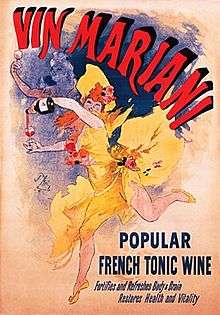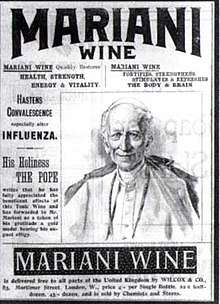Vin Mariani

Vin Mariani (French: Mariani wine) was a tonic and patent medicine created about 1863 by Angelo Mariani, a French chemist from the island of Corsica who became intrigued with coca and its economic potential after reading Paolo Mantegazza’s paper on coca's effects. In 1863[1][2] Mariani started marketing a coca wine called Vin Tonique Mariani (à la Coca du Pérou)[1] which was made from Bordeaux wine and coca leaves.[3]
The ethanol in the wine acted as a solvent and extracted the cocaine from the coca leaves, altering the drink's effect. It originally contained 6 mg of cocaine per fluid ounce of wine (211.2 mg/L), but Vin Mariani that was to be exported contained 7.2 mg per ounce (253.4 mg/L), in order to compete with the higher cocaine content of similar drinks in the United States. Advertisements for Vin Mariani claimed that it would restore health, strength, energy and vitality.
Promotion and testimonials
Mariani marketed the Vin Mariani for a number of ailments, touting its ability to increase energy, appetite and mood.[4] It was promoted as a performance enhancer for creatives and athletes alike, and was endorsed by many notable people of its time.[4] Mariani solicited testimonials from a broad range of European celebrities, including members of various royal families, politicians, artists, writers and other household names, and reprinted them in newspapers and magazines as advertisements. He claimed to have collected over four thousand such endorsements.[5]
Pope Leo XIII and later Pope Saint Pius X were both Vin Mariani drinkers.[6] Pope Leo appeared on a poster endorsing the wine and awarded a Vatican gold medal to Mariani for creating it.[3] Thomas Edison claimed it helped him stay awake longer.[3] Ulysses S. Grant drank Vin Mariani while writing his memoirs towards the end of his life.[7] Jules Méline, the French prime minister, drank the wine despite being otherwise anti-alcohol.[4]
Other notables who endorsed Vin Mariani include Émile Zola, Victorien Sardou, Henri Rochefort and Charles Gounod, all of whom wrote testimonials that appeared as Vin Mariani advertisements.[5]
Inspiration for Coca-Cola
This tonic evidently inspired John S. Pemberton's 1885 coca wine drink, Pemberton's French Wine Coca. Pemberton's recipe was very similar to that of Vin Mariani, including the coca leaves. It was differentiated only by the inclusion of the African kola nut, the beverage's source of caffeine.[8] Later that year, when Atlanta and Fulton County, Georgia, passed prohibition legislation, Pemberton responded by developing a carbonated, non-alcoholic version of his French Wine Coca. He called the reformulated beverage Coca-Cola, for its stimulant ingredients coca leaves and kola nuts.[8]
Modern developments
Angelo Mariani failed to pass his cocawine production secrets down to subsequent Mariani family generations. However, Christophe Mariani, a possible descendant of Angelo Mariani, relaunched the product in 2014.[9] Christophe Mariani subsequently met the Bolivian president, Evo Morales, in Rome to discuss the commercialisation of Mariani cocawine in Bolivia.[10][11]
Gallery
 Pope Leo XIII purportedly carried a hipflask of Vin Mariani with him, and awarded a Vatican gold medal to Angelo Mariani.
Pope Leo XIII purportedly carried a hipflask of Vin Mariani with him, and awarded a Vatican gold medal to Angelo Mariani.- Vin Mariani medal by Louis-Oscar Roty
- Medal of Coca Mariani wine
_faisant_la_publicit%C3%A9_du_Vin_Mariani%2C_pr%C3%A9curseur_du_Coca-Cola..jpg) French historian Louis Duchesne and Vin Mariani
French historian Louis Duchesne and Vin Mariani
References
- 1 2 "Angelo Mariani – Man Behind The Bottle – Discover". Exposition Universelle des Vins et Spiritueux.
- ↑ There are some conflicting information on the actual dates, see Karch, Steven B. "A Brief History of Cocaine". Taylor & Francis Group. Boca Raton, FL. 2006. Page 32.
- 1 2 3 Inciardi, James A. (1992). The War on Drugs II. Mayfield Publishing Company. p. 6. ISBN 1-55934-016-9.
- 1 2 3 Bock, Gregory R.; Whelan, Julie (2008-04-30). Cocaine: Scientific and Social Dimensions. John Wiley & Sons. pp. 7–8. ISBN 9780470514252.
- 1 2 French, J. L. (1897-06-15). "Vin Mariani". Profitable Advertising. Kate E. Griswold. 7: 284–288.
- ↑ Kennedy, Joseph (1985). Coca exotica: the illustrated story of cocaine. Fairleigh Dickinson University Press. p. 86. ISBN 9780845347782.
- ↑ Dwight Garner (July 19, 2011). "The Lure of Cocaine, Once Hailed as Cure-All". The New York Times.
- 1 2 Blanding, Michael (2010). The Coke machine : the dirty truth behind the world's favorite soft drink. New York: Avery. p. 14. ISBN 9781583334065. OCLC 535490831.
- ↑ Spisani (2016). "La renaissance du vin Mariani une affaire qui coule de source". Retrieved July 14, 2018.
- ↑ "Vin Tonique Mariani Site Officiel".
- ↑ Padovani, Ghjilormu (2016). "Le vin corse Mariani en passe de conquérir... la Bolivie". Retrieved July 14, 2018.
External links